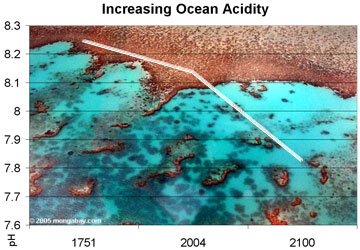Ocean acidification monitoring system launched
mongabay.com
June 13, 2007
The first buoy to monitor ocean acidification has been launched in the Gulf of Alaska reports the National Science Foundation (NSF). Scientists hope the instrument, which will transmit data via satellite, will help examine how ocean circulation and ecosystems interact to determine how much carbon dioxide the north Pacific Ocean absorbs each year.
Studies have shown that increased atmospheric carbon dioxide levels are acidifying the world’s oceans. This is significant for coral reefs because acidification strips carbonate ions from seawater, making it more difficult for corals to build the calcium carbonate skeletons that serve as their structural basis. Research has shown that many species of coral, as well as other marine microorganisms, fare quite poorly under the increasingly acidic conditions forecast by some models.
 Observed and projected decline in global ocean pH, 1750-2100. Photo by Rhett A. Butler |
“Information from this buoy will lead to a better understanding of ocean acidification–a growing threat to the world’s oceans–by helping scientists determine exactly how physical and biological processes affect carbon dioxide in the north Pacific Ocean,” said Fred Lipschultz, program director in NSF’s division of ocean sciences.
“The Gulf of Alaska region is particularly important because it is likely to be one of the first regions to feel the impacts of ocean acidification,” said Christopher Sabine, an oceanographer at NOAA’s Pacific Marine Environmental Laboratory.
Related news